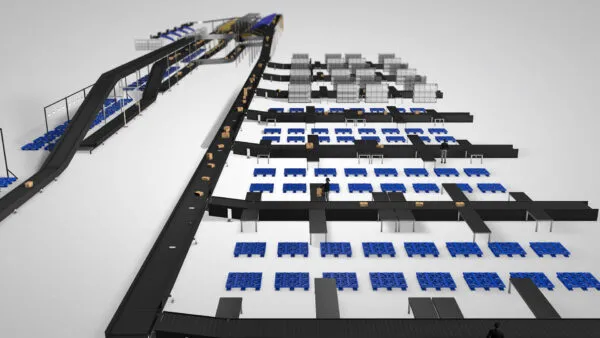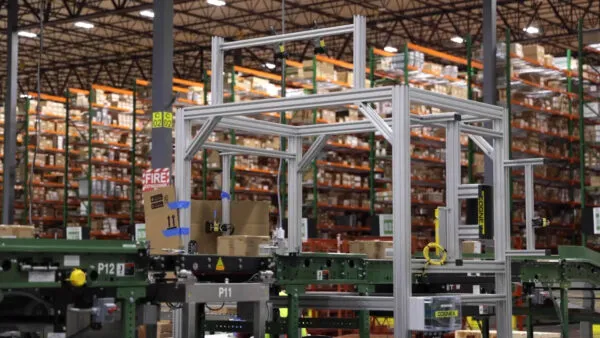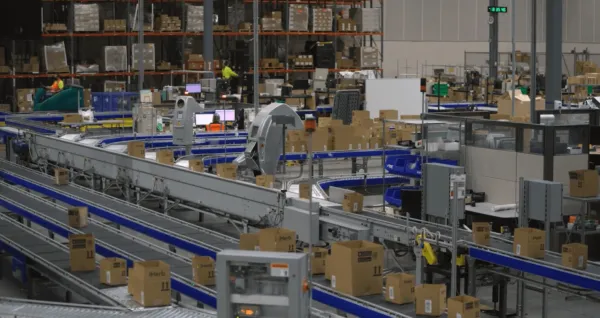This site is protected by reCAPTCHA and the Google Privacy Policy and Terms of Service apply.
Boost Productivity & Profits: The 5 Key Benefits of DATUM

In today’s fast-paced, competitive business landscape, warehouse efficiency is paramount. To stay ahead, businesses must optimize operations, reduce costs, and enhance customer satisfaction. This is where a robust warehouse execution system (WES) like DATUM comes into play.
DATUM from Designed Conveyor Systems (DCS) is more than just software; it’s a strategic tool designed to efficiently work with your processes. DATUM optimizes order picking, packing, and shipping processes, ensuring orders are fulfilled accurately and efficiently. With real-time inventory visibility and advanced algorithms, DATUM minimizes picking errors, reduces order cycle times, and improves customer satisfaction.
By streamlining workflows across multiple automated technologies, improving visibility, and enabling data-driven decision-making, DATUM can significantly boost your productivity and profitability. Here are five key benefits of implementing DATUM in your warehouse:
1. Seamlessly Integrate with Your Current Operations
DATUM is engineered with a flexible, secure API gateway and integration bridge. These functions allow the WES to interface easily with the vast majority of warehouse management system (WMS) softwares. Whether an operation uses a WMS from a major software brand, a custom solution, or a legacy system, DATUM can connect and communicate with it. DATUM also interfaces with enterprise resource planning (ERP) systems. This advanced connectivity enables operations to increase their agility by expanding current capabilities beyond the limitations of any existing WMS software.
In addition to integrating with existing inventory and business management softwares, DATUM interfaces with a broad array of automated and semi-automated equipment and technologies from any original equipment manufacturer (OEM). It links with systems utilizing either native programmable logic controller (PLC) or Ethernet-based control. This allows for seamless synchronization of workflows across existing and updated equipment, as well as with new material handling technologies.
DATUM connects to conveyor and sortation systems; fleets of autonomous mobile robots (AMRs) and automatic guided vehicles (AGVs); goods-to-person (G2P) automated storage and retrieval systems (AS/RS); light- and voice-directed picking systems; pick and put walls; mobile devices; print-and-apply labelers; auto-baggers and on-demand cartonization equipment; and conventional and robotic palletizers.
Because it plays well with others, DATUM efficiently orchestrates entire workflows, end-to-end. From receiving and put away to storage, retrieval, and replenishment, through order picking, consolidation, and packout to parcel sortation and shipping, DATUM allocates and parses tasks across different handling processes. Based on pre-set operating parameters, it releases work in waves timed to maintain balance throughout a facility. It also continuously monitors progress, exceptions, and changing priorities. This allows DATUM to make adjustments as necessary, reallocating tasks and orders to optimize associate productivity for maximum throughput while eliminating bottlenecks and idle time. The result? Greater profitability.
2. Improved Inventory Management
Thanks to its interface with the facility’s WMS, DATUM manages and directs real-time inventory handling and tracking—as well as order flow—throughout a warehouse. This helps a facility maintain optimal stock levels and prevent stockouts or overstocking.
To do this, DATUM utilizes multiple, sophisticated strategies, including dynamic and intelligent inventory, equipment, container, and order management. Among them are:
- Buffer lane management
- Container configuration, lifecycle, and routing
- Conveyor and equipment modeling
- Destination mapping and optimization
- Dimensioning and weight validation
- Inventory auditing
- Label and print management
- Location inventory management
- Order management and release
- Order soft and hard allocation
- Pick and put order fulfillment
- Pick consolidation
- Pick path optimization
- Replenishment
- Wave release
- Waveless workflow optimization
DATUM further improves Inventory management via real-time and continuous analysis of order requirements, inventory volumes, and stock positions. This enables the WES to automatically know when a pick face needs replenishment, for example. Before the pick face becomes empty, DATUM proactively sends a replenishment command to reserve storage, minimizing downtime.
DATUM also monitors KPIs and provides reports that track trends, including the cycle time of replenishment request completions for continuous improvement measures. DATUM additionally identifies which stock keeping units (SKUs) and locations are depleted most frequently. This aids in better planning to reduce backorders and improve customer service.
3. Easy to Read Dashboard
To further help operations managers and authorized users monitor performance trends, DATUM offers an advanced dashboard function. The WES’ dashboards and the reports they display are fully customizable via drag-and-drop functionality. This allows managers to control what information restricted users can—and cannot—access. Dashboard layouts can be created dynamically for each functional area within a warehouse, allowing full visualization of processes in real-time.
The information DATUM synthesizes and analyzes in real-time is presented in the user customized dashboards. Among the reports shared are actionable key performance indicators (KPIs) in a range of formats, including tables and graphs. Users determine the KPIs they wish to track, including metrics on order fill rates, associate productivity, throughput, inventory availability, and much more. This information can be used for incentivization, exception management, and to identify areas for improvement to enhance productivity and profitability.
Additionally, DATUM displays graphical illustrations of key workflows and equipment across the entire system. Users can see at a glance which processes are flowing as expected, which are at risk of a fault or error, which have slowed due to bottlenecks, and which have stopped completely. DATUM automatically calls attention to all areas of concern. This allows operations managers to proactively address an issue, rather than analyzing data log files after the problem occurs to identify operating faults, order handling exceptions, stockouts, reducing the risk of unplanned downtime..
4. Enhanced Warehouse Visibility
In addition to boosting visibility into operational performance via customizable dashboards and reporting, DATUM offers an advanced search function. This gives users even greater visibility by supporting intuitive access to all types of data and information.
Via a user interface similar to that of a browser-based search engine, DATUM supports full text searches across a diverse range of datasets. The WES efficiently stores structured and unstructured text, event and timestamp data, numerical data, and more, indexing it in a way that enables fast query results in near real-time. DATUM users can quickly search for anything, such as orders, exceptions, specific containers, workflow processes, errors, KPIs, and more.
Beyond data retrieval, DATUM’s search feature also provides analytics for a variety of datasets. It aggregates information to identify and document trends and patterns in data. Further, DATUM supports searches of events with tags to help troubleshoot and diagnose problems with equipment and orders to speed up resolution.
5. OpsTeams makes it easy to share data points
Advanced, cross-functional collaboration via DATUM’s OpsTeams groups allows multiple team members to share information and data points collected in the WES—both within the application and externally. The WES interfaces with a variety of collaborative messaging softwares, including Microsoft Teams and Slack. This enables easy sharing of key informational data—including clipboards—among colleagues, whether they are authorized DATUM users or not, in a universally accessible system.
These include details about:
- Status of specific totes or orders
- Open picks
- Out-of-stock locations
- Exception handling
- Key performance indicators (KPIs) and metrics, including pick rates per hour, workflow balancing, anticipated associate idle time, and more
- Equipment performance and projected maintenance needs
By sharing notifications, dashboard views, and data points among internal stakeholders, DATUM enables faster response times for issue resolution—whatever the issue may be. This cross-functional approach aligns priorities while preventing bottlenecks and unnecessary downtime.
Learn More About the Benefits of DATUM WES for Your Operation
By leveraging the power of DATUM, businesses can achieve significant improvements in warehouse efficiency, productivity, and profitability. Ready to transform your warehouse operations? Contact us today to learn more about how DATUM can benefit your business. Contact Designed Conveyor Systems to learn more about our WES and how it can impact your facility.














